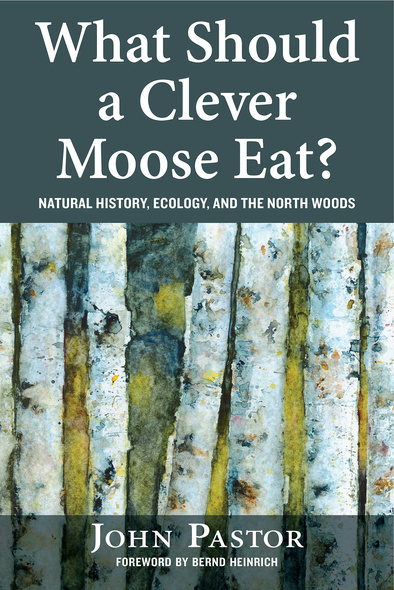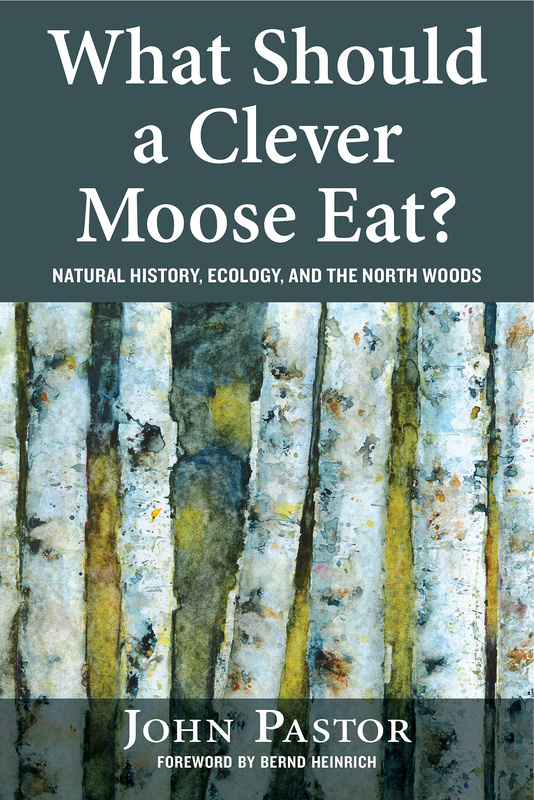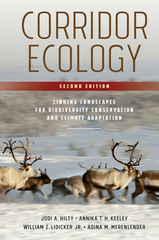What Should a Clever Moose Eat?
Natural History, Ecology, and the North Woods
By John Pastor; Foreword by Bernd Heinrich
Island Press
How long should a leaf live? When should blueberries ripen? And what should a clever moose eat? Questions like these may seem simple or downright strange—yet they form the backbone of natural history, a discipline that fostered some of our most important scientific theories, from natural selection to glaciation. Through careful, patient observations of the organisms that live in an area, their distributions, and how they interact with other species, we gain a more complete picture of the world around us, and our place in it.
In What Should a Clever Moose Eat?, John Pastor explores the natural history of the North Woods, an immense and complex forest that stretches from the western shore of Lake Superior to the far coast of Newfoundland. The North Woods is one of the most ecologically and geologically interesting places on the planet, with a host of natural history questions arising from each spruce or sugar maple. From the geological history of the region to the shapes of leaves and the relationship between aspens, caterpillars, and predators, Pastor delves into a captivating range of topics as diverse as the North Woods themselves. Through his meticulous observations of the natural world, scientists and nonscientists alike learn to ask natural history questions and form their own theories, gaining a greater understanding of and love for the North Woods—and other natural places precious to them.
In the tradition of Charles Darwin and Henry David Thoreau, John Pastor is a joyful observer of nature who makes sharp connections and moves deftly from observation to theory. Take a walk in John Pastor's North Woods—you'll come away with a new appreciation for details, for the game trails, beaver ponds, and patterns of growth around you, and won't look at the natural world in the same way again.
In What Should a Clever Moose Eat?, John Pastor explores the natural history of the North Woods, an immense and complex forest that stretches from the western shore of Lake Superior to the far coast of Newfoundland. The North Woods is one of the most ecologically and geologically interesting places on the planet, with a host of natural history questions arising from each spruce or sugar maple. From the geological history of the region to the shapes of leaves and the relationship between aspens, caterpillars, and predators, Pastor delves into a captivating range of topics as diverse as the North Woods themselves. Through his meticulous observations of the natural world, scientists and nonscientists alike learn to ask natural history questions and form their own theories, gaining a greater understanding of and love for the North Woods—and other natural places precious to them.
In the tradition of Charles Darwin and Henry David Thoreau, John Pastor is a joyful observer of nature who makes sharp connections and moves deftly from observation to theory. Take a walk in John Pastor's North Woods—you'll come away with a new appreciation for details, for the game trails, beaver ponds, and patterns of growth around you, and won't look at the natural world in the same way again.
Even if you've never been to the North Woods...you will come to appreciate it through ecologist Pastor. With an eye for fine detail and the gentle explication of a born teacher, Pastor crafts a rich biography of one of North America's most beautiful and diverse ecosystems, from the geology of its foundations to the birds in its skies.'
'Evocative, multilayered and fascinating book...an elegant and multi-tiered examination of the complexity and interplays of a region’s current, past and future ecology'
Pastor's book does more than answer the question 'what should a clever moose eat?' It helps explain why we should care.
An intellectual descendant of Aldo Leopold, Pastor chooses a domain far wider than the area of Sand County, encompassing the whole of the North Woods...[b]ut his perceptive love for the ecosystem shines through just as brilliantly as Leopold’s did...As he considers the intricate natural details of the place…Pastor reveals an ethos that stewards of the land can (and probably should) apply on a global scale.
It’s a celebration of curiosity. It will make your own walk in the woods a richer experience. And it showcases that a lot of scientific advancement still begins with an open mind, out in nature.
I strongly recommend the author's pensive essays on the evolution of a system he is clearly passionate about, and without dispute expert in...The author makes a great case for why we can all learn from the North Woods...his examples and prose are vivid and rousing...Without reservation, I recommend Pastor's volume and hope that readers find as much enjoyment and inspiration in its pages as I found.
Anyone who has dipped a paddle in a northern lake–or even dreamed of doing so–will be rewarded by mind-expanding dips into this celebration of curiosity, science, and the nature of a very special ecosystem.
If your first imaginary visit to the North Woods was through Henry David THoreau's writings, going back with Pastor is a totally different and beautiful way to relive it...the book is nice reading and the author's holistic way of presenting complexity is a notable strength.'
An interesting and informative read from start to finish.
'I took a job in the Great North Woods,' wrote Bob Dylan, and so did John Pastor. Unlike those who took to the woods before, Pastor brought back not fur and fiber, but facts—from the optimal shape of trees to the best bill size for birds that eat their cones. Few books capture the natural history of a storied land—and the importance of natural history itself—as does this one, in John Pastor’s graceful words and drawings.
In What Should a Clever Moose Eat?, John Pastor mounts a strong defense of natural history, reminding us that all good questions in science come from the observation of nature by a questioning mind. Pastor has an obvious love for the natural history and ecology of the North Woods, and this, coupled with his skillful writing, make his wide-ranging but connected set of essays a success.
Pastor weaves a passion for the North Woods’ beauty with deep insight into the area’s natural history. With an expert eye, Pastor describes the slow grind of glaciers across the ages, beavers damming the land into a waterscape, and the intricate connections between voles and the creation of spruce forests or meadows. This book is a valuable guide to understanding how ecosystems develop, function, and change.
Pastor writes with striking simplicity despite the detailed and sometimes complex descriptions of how the North Woods was created, its structure, and how it functions. Given the straightforward writing and glossary of terms, this book should be accessible to the layperson, yet also informative and educational for the seasoned ecologist. pastor combines his years of scientific writing experience as a professor at the University of Minnesota-Duluth with poetic prose, making this book a pleasure to read.'
John Pastor is an ecologist and professor of biology at the University of Minnesota, Duluth, where his teaching and research focus on the natural history and ecology of northern ecosystems. Pastor is the author of Mathematical Ecology of Populations and Ecosystems, is co-editor of Large Mammalian Herbivores, Ecosystem Dynamics, and Conservation, and has authored or coauthored 22 book chapters and over 120 papers, mostly about the North Woods. He is co-chair of the Natural History Section of the Ecological Society of America.
Foreword
Preface
Prologue: The Importance of Natural History
Introduction: The Nature of the North Woods
PART I: The Assembly of a Northern Ecosystem, and the Discovery of its Natural History
Chapter 1. Setting the Stage
Chapter 2. The Emergence of the North Woods
Chapter 3. The Birth and Death of a Beaver Pond
Chapter 4. David Thompson’s Canoe
PART II: Capturing the Light
Chapter 5. How Long Should a Leaf Live?
Chapter 6. The Shapes of Leaves
Chapter 7. The Shapes of Crowns
Chapter 8. How Should Leaves Die?
PART III: Foraging and Food Webs
Chapter 9. Foraging in the Beaver’s Pantry
Chapter 10. Mouse Wars, Fungi, and Spruce
Chapter 11. What Should a Clever Moose Eat?
Chapter 12. Tent Caterpillars, Aspens, and the Regulation of Ecosystems
Chapter 13. The Diversity of Warblers and the Control of Spruce Budworm
Chapter 14. The Dance of Hare and Lynx
PART IV: Pollinators, Flowers, Fruits, and Seeds
Chapter 15. Skunk Cabbages, Blowflies, and the Smells of Spring
Chapter 16. When Should Flowers Bloom and Fruits Ripen?
Chapter 17. Everybody’s Favorite Berries
Chapter 18. Coevolution of Crossbills and Conifer Cones
PART V: Fire and the Dynamics of the Landscape
Chapter 19. Does Fire Destroy or Maintain the North Woods?
Chapter 20. The Legacies of a Fire
Chapter 21. The Correlated Evolution of Serotiny, Flammability, and Fire
Epilogue: Climate Change and the Disassembly of the North Woods
Postscript: The Beauty of Natural History
Bibliography
Preface
Prologue: The Importance of Natural History
Introduction: The Nature of the North Woods
PART I: The Assembly of a Northern Ecosystem, and the Discovery of its Natural History
Chapter 1. Setting the Stage
Chapter 2. The Emergence of the North Woods
Chapter 3. The Birth and Death of a Beaver Pond
Chapter 4. David Thompson’s Canoe
PART II: Capturing the Light
Chapter 5. How Long Should a Leaf Live?
Chapter 6. The Shapes of Leaves
Chapter 7. The Shapes of Crowns
Chapter 8. How Should Leaves Die?
PART III: Foraging and Food Webs
Chapter 9. Foraging in the Beaver’s Pantry
Chapter 10. Mouse Wars, Fungi, and Spruce
Chapter 11. What Should a Clever Moose Eat?
Chapter 12. Tent Caterpillars, Aspens, and the Regulation of Ecosystems
Chapter 13. The Diversity of Warblers and the Control of Spruce Budworm
Chapter 14. The Dance of Hare and Lynx
PART IV: Pollinators, Flowers, Fruits, and Seeds
Chapter 15. Skunk Cabbages, Blowflies, and the Smells of Spring
Chapter 16. When Should Flowers Bloom and Fruits Ripen?
Chapter 17. Everybody’s Favorite Berries
Chapter 18. Coevolution of Crossbills and Conifer Cones
PART V: Fire and the Dynamics of the Landscape
Chapter 19. Does Fire Destroy or Maintain the North Woods?
Chapter 20. The Legacies of a Fire
Chapter 21. The Correlated Evolution of Serotiny, Flammability, and Fire
Epilogue: Climate Change and the Disassembly of the North Woods
Postscript: The Beauty of Natural History
Bibliography






